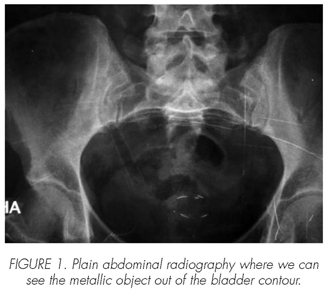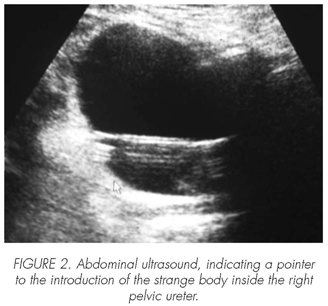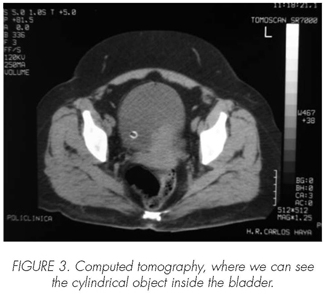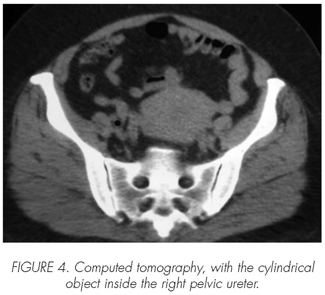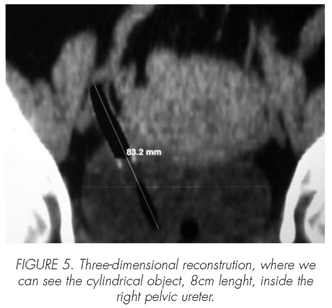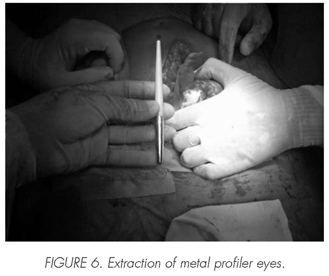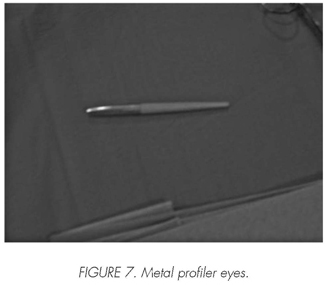My SciELO
Services on Demand
Journal
Article
Indicators
-
 Cited by SciELO
Cited by SciELO -
 Access statistics
Access statistics
Related links
-
 Cited by Google
Cited by Google -
 Similars in
SciELO
Similars in
SciELO -
 Similars in Google
Similars in Google
Share
Archivos Españoles de Urología (Ed. impresa)
Print version ISSN 0004-0614
Arch. Esp. Urol. vol.62 n.3 Apr. 2009
Intraureteral foreign body
Cuerpo extraño intraureteral
David Hernández Alcaraz, Raúl Vozmediano Chicharro, Pedro Morales Jiménez, Eloy Vivas Vargas, Emilio José Emmanuel Tejero, Francisco Blanco Reina, José María Del Rosal Samaniego y Víctor Baena González.
Urology Department. University Regional Carlos Haya Hospital. Malaga. Spain.
SUMMARY
Objective: We present a rare localization for a foreing body in the urinary system, and review the bibliography to know about it existence, frequency and localization.
Methods: We present the case of a 49 year old woman who referreds she had introduced a metallic objet in her genital area.
Results: After the necessary tests, we could see a metallic cylinder. It was 8 cm long and was localized inside the right pelvic ureter.
Conclusions: The presence of strange bodies in the urinary system is a rare urological emergency. Treatment is the key element of the extraction of the least bloody way possible.
Key words: Strange body. Pelvic ureter.
RESUMEN
Objetivo: Presentar una localización atípica de cuerpos extraños en el interior del aparato urinario, así como revisar en la bibliografía su existencia, frecuencia y localización.
Métodos: Presentamos el caso de una mujer de 49 años, que refiere la introducción de un objeto metálico en el área genital.
Resultados: Tras la realización de las pruebas complementarias pertinentes, se objetiva un cilindro metálico de 8 cm de longitud, localizado en el interior del uréter pelviano derecho.
Conclusion: La presencia de cuerpos extraños en el interior del aparato urinario es una rara urgencia urológica, su tratamiento fundamental consiste en la extracción del elemento de la manera menos cruenta posible.
Palabras clave: Cuerpo extraño. Ureter pelviano.
Introducción
The medical literature refers to the existence of large numbers of cases about strange bodies inside the urinary system. They are related to psychological and social conditions, psychiatric disorders, attempted escape (prisoners) and genitourinary injuries in children.
Clinical case
We show the case of a woman of 49 years old, without interesting history, who goes to the emergency in our hospital because she refers the introduction of a metallic object in her genital area during erotic-sex practices.
Clinically, the patient was asymptomatic, and the genital exploration did not show any material inside the vagina.
The plain abdominal radiograph showed a metallic object that excelled the contour of the urinary bladder (Figure 1). Finally, we decide to do an ultrasound scan (Figure 2), followed by an abdominal CT one, which showed a metallic object of 8 cm length inside the right pelvic ureter (Figures 3, 4 and 5).
We decided to operate on and we did a cystoscopy under general anesthesia, objectifying the metallic cylinder that protrudes inside the right ureteral orifice.
It was impossible to remove the object by endoscopic surgery and we had to realized a half infraumbilical laparotomy, opening the bladder and removing the metallic cylinder of 8cm length, corresponding to a profiler eyes (Figures 6 and 7).
Comments
Most self-made strange bodies happen during on erotic-sexual act because many patients try to hide it or to delay medical help until the clinic is intense enough. That is why we must be alert to symptoms that we cannot fit in another disease, specially with mentally handicapped patients, which this entity is associated with some frequency (1).
The most frequent clinic includes accidental finding of strange bodies in a plain X-ray or abdominal ultrasound. However, some patients are alarmed after the introduction of the object and ask for medical attention. The symptoms usually do not appear inmediatelly, it may appear some months later like hypogastric discomfort, with low urinary tract symptoms. Some patients have recurrent infections that often not respond to the therapy and which are produced by multirresistant strains. Less frequently provides obstructive renal failure. Because of the morphological characteristics of the objects is rare spontaneous expulsion (2).
Many and varied are the strange bodies that have been identified into the urinary system, either directly or as a calcification or stones containing the object inside. These includes:
• The stick of candy like "chupa-chups" (2).
• A string of accounts used bye Norwegian troops to count the remaining days of service.
• An electric wire was introduced into the bladder. The idea was promoting the evacuation of a ballon bladder (3).
• A stone of 360 grams which housed inside three meters of nylon thread fishing (2).
• Thermometers accidental complication in taking temperature vaginally.
• Pencils in some cases of mentally handicapped patients.
• Toothbrushes.
• Screws (4).
• Hair forks (5).
• Drinking straws(1).
Also strange bodies can be found inside the urinary system rather than introduction, but by migration from other places, such as:
• Penile prothesis (6) or reservoir of the prothesis AMS 800, which have passed into the bladder bye erosion of it.
• Surgical material used in radical prostactectomy or incontinence surgery, which often take the form of bladder stones (7).
• There are many cases of migration into the bladder of intrauterine devices (lUDs). It's difficult to diagnose if the patient does not have any symptom because it anatomical situation makes radiological controls are not suggestive.
• Vaginal pessary, forgotten in an old lady, that goes bye erosion into the bladder (4).
Another situation involves the presence of objects, which have been introduced by a projectile due to injury or assault by firearms (4).
The treatment depends on the location of the strange body, its size, shape and mobility, gender and age of the patient, and the presence of associated lesions. Having analyzed these features, and whenever possible, the most recommended for the removal of strange body is the endoscopy, but on rare occasions is necessary the open on.
If the strange body is quite large, impacted in the urethra, with jagged edges or sharp edges that could be dangerous for the integrity of the mucosa or urethral sphincter and result in the further development of stenosis or urinary incontinence, or injuries or abscesificates areas associated, it would be better to reject the transurethral removal and carry out with other techniques such as percutaneous from the bladder or the open (1).
The percutaneous approach is performed through a suprapubic bladder puncture in which, after a gradual expansion, a cystoscope is introduced to purse the collection, minimizing the damage to the urethral mucosa (10).
We reserved the open surgery as a last resort when the characteristics or the severy of injuries associated with the strange body, such as fistulas or abscesses, forced to dismiss the transurethral endoscopic approach or percutaneous techniques (1).
Techniques have been abandoned long ago that consisted of instilling benzene, kerosene, or other similar chemicals for dissolving the foreign body and then facilitate their removal (4).
Conclusions
The presence of strange bodies into the urinary system is not a common emergency in the urological field. The main treatment is to remove the element, with the less damage possible. Furthermore, because of the nature of the phenomenon in certain cases, some patients require psychiatric and psychological support.
 Correspondence:
Correspondence:
David Hernández Alcaraz
Servicio de Urología
Hospital Civil
Plaza de Hospital Civil s/n.
29009 Málaga. (Spain).
davidhauro@hotmail.com
Accepted for publication: February, 27th 2008.
References and recomended readings (*of special interest, **of outstanding interest)
**1. Bosquet Sanz M, Gimeno Argente V, Palmero Martí JL, et al. Cuerpos extraños uretrovesicales: Nuestra experiencia. Actas Urol Esp, 2005; 29: 72-77. [ Links ]
*2. Pascual Regueiro D, García de Jalón Martínez A, Mallén Mateo, et al. Cuerpos Extraños Intravesicales. Revisión de la Literatura. Actas Urol Esp , 2003; 27:265-273. [ Links ]
3. Sánchez Salabardo D, Cuesta Presedo JM. Cuerpo extraño intravesical. Actas Urol Esp, 2006; 30: 646. [ Links ]
**4. Van Ophoven, A; Dekernion, JB. Clinical management of foreign bodies of the genitourinary tract. J Urol, 2000; 164: 274-287. [ Links ]
5. Sukkarieh T, Smaldone M. Multiple Foreign Bodies In The Anterior And Posterior Urethra. International Braz J Urol, 2004; 30: 219-220. [ Links ]
6. Swana HS, Foster HE Jr. Erosion of malleable penile prosthesis into bladder. J Urol, 1997; 157: 2259-2260. [ Links ]
7. Ascaso Cornago I, Sánchez Zalabardo D, Cuesta Presedo JM. Cuerpo extraño vesical. Actas Urol Esp, 2006; 30: 341. [ Links ]
8. Atasoy C, Fitoz S, Akyar S. Bladder stone caused by an ectopic intrauterine contraceptive device: case report. Can Assoc Radiol J, 2001; 52: 33-34. [ Links ]
9. Pajor L, Szabo V. Bladder stone formation on a swallowed knife blade and spontaneous passage through a vesicovaginal fistula. Br J Urol, 1995; 76: 659. [ Links ]
10. Johnin K, Kushima M, Koizumi Sh, et al. Percutaneous transvesical retrieval of foreign bodies penetrating the urethra. J Urol, 1999; 161:915-916. [ Links ]











 text in
text in 

